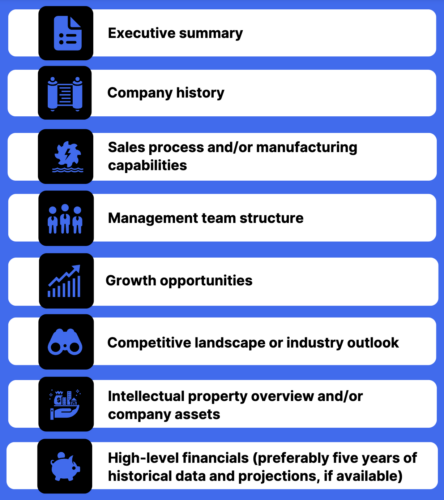Provided Courtesy of Kaitlinn Thatcher of Axial.net
The CIM, also referred to as the Offering Memorandum (OM), Information Memorandum (IM), or pitch book, explains in more detail the intricacies of the company being sold and the long-term value of the business.
Although most business owners realize the importance of investing hundreds of thousands of dollars annually in high-quality marketing materials to sell their products and services, many fail to appreciate the importance of having professionally prepared materials when it comes time to explore an M&A transaction.
Having a robust set of investment marketing materials will have a substantial impact on the success of the M&A process in two primary areas:
- Speed: The more questions answered in your marketing materials, the fewer one-off questions you must answer from a potential buyer. This becomes particularly important the longer your business is on the market. It can be easy to lose momentum as the deal process drags on. By anticipating potential buyers’ questions in advance, you’ll make it easier for them to assess their level of interest more quickly — and avoid wasted time on both sides.
- Buyer perception: Human beings are heavily influenced by the appearance of things, and potential buyers are no exception. Presenting your business as professionally as possible in marketing materials is worth the investment. You’ll attract more serious buyers, who will likely (consciously or not) be willing to pay more for your business than they would on an equal organization with amateur materials.
Why do you need a CIM?
After a potential buyer signs your NDA, what do you do next? This is where the CIM comes in. The purpose of the CIM is to help a buyer understand your business and the unique strategic investment opportunity it presents The components of a CIM vary depending on the company’s industry and unique characteristics.
Many CIMs contain the following components:

Imagine you approach 20 carefully targeted potential buyers. Ten of the buyers express a preliminary level of interest, sign an NDA, and ask for more information. Without a CIM, the next step would be participating in 10 separate conference calls with each buyer, in which you would answer some of the exact same questions over and over again. The conference call would lead to more one-off phone calls and emails.
With a CIM, you can accomplish the equivalent of these conference calls, phone calls, and emails with one document. Once a buyer has reviewed the CIM, they can quickly determine if they want to pass or move to the next stage in the deal process, typically a conference call with the business owner. This call with be a more in-depth conversation covering topics like the owner’s personal goals, valuation, and desired deal structure.
Buyers will always want to speak with business owners and management over the phone, visit the company in person, meet the team, and tour the facilities to get a clear picture of your business. But a CIM can and should set the tone for all discussions and set expectations in a transaction. Sharing a CIM is the most productive and efficient way to determine a qualified buyer’s level of interest.
Should I have a CIM even if I’m not actively selling?
Even if you are not actively selling your business, there are several reasons to have a prepared CIM on hand. Creating a CIM often helps business owners uncover issues in the company (e.g., large customer concentration, unscalable processes, or a lack of suitable management expertise in place) that can be corrected before selling the company. The CIM can help owners visualize their business from the perspective of a buyer and identify potential sticking points (e.g., large customer concentration or lack of management expertise) and opportunities for improvement. The CIM can also serve as a useful tool when approaching commercial banks for a loan. Lastly, a good CIM can be used in emergency situations (e.g., your plant burns down, you lose a key manager or owner to illness, major personal financial change of status, etc.).
Don’t go it alone
Just as you would not put together professional marketing materials for your business without the help of a marketing professional, you should also enlist the help of a qualified professional to help prepare the CIM for your company.
Your options include:
- Hiring a professional investment bank. Qualified investment banks have extensive experience building these materials. Ask them for samples so you can get familiar with their work; some banks might be a better fit for your business and style than others.
- Hire an M&A consultant. This can be a more economical solution and allows you to get outside assistance without the expectation that you are planning to sell your business immediately. Before engaging a consultant, ask to speak to references, see specific deals or projects they’ve worked on, and look at samples of past prepared materials.
- Work with your CFO. This is the least expensive option, but it can be risky if your CFO doesn’t have materials preparation skills. For many small businesses, this is a good place to start. Begin aggregating the key materials, then consider handing them over to a consultant or bank for the final compilation and review.
Committing the necessary resources is key to producing a successful and professional CIM. Buyers will be turned off by incomplete or amateur documentation, and in turn, think poorly of your business, lowball the valuation, or simply ignore you. If you’re serious about selling (either now or in the future), your investment in the CIM will pay off.


